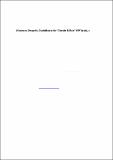Por favor, use este identificador para citar o enlazar a este item:
http://hdl.handle.net/10261/45795COMPARTIR / EXPORTAR:
 SHARE SHARE
 CORE
BASE CORE
BASE
|
|
| Visualizar otros formatos: MARC | Dublin Core | RDF | ORE | MODS | METS | DIDL | DATACITE | |

| Título: | Population structure and reproductive biology of the stone crab Xantho poressa (Crustacea: Decapoda: Xanthidae) in the ‘Corrales de Rota’ (south-western Spain), a human-modified intertidal fishing area |
Autor: | Spivak, Eduardo D.; Arévalo, Elisabeth; Cuesta, José A. CSIC ORCID ; González-Gordillo, J. Ignacio CSIC ORCID | Palabras clave: | Xanthidae Corrales de Pesca Hepatosomatic index Gonadosomatic index Fecundity Handedness Rhythms Matting systems |
Fecha de publicación: | 9-jul-2009 | Editor: | Marine Biological Association of the United Kingdom | Citación: | Journal of the Marine Biological Association of the United Kingdom 90(2): 323-334 (2010) | Resumen: | The present study describes the reproductive biology, population structure and life history traits of the abundant intertidal crab Xantho poressa. Between March 2007 and April 2008, a total of 1918 individuals were collected in Corrales de Rota (south-western Spain), a human-modified intertidal habitat characterized by an artificial high complexity. Suitable refuges for crabs (cobbles and boulders) are very abundant in this area and density (maximum of 50 ind*m−2) was directly related with the area covered by these stones. In spring and summer, size–frequency distributions showed a polymodal pattern with seasonal variations related to the incorporation of juveniles to the adult population. Newly settled juveniles were not found in the Corrales suggesting an ontogenetic migration from a distant recruitment habitat. The annual reproductive cycle was seasonal and successive peaks in the abundance of ovigerous females were observed in late spring and summer. Females probably produced multiple broods during a long intermoult period. The gonadosomatic index had a cyclic pattern of variation with peaks two weeks prior to those of ovigerous females; it was lower during the non-reproductive season. The hepatosomatic index was high during spring, decreased during summer and increased gradually at the end of the reproductive season. There was a monthly cycle of larval release resulting from a combination of a cyclic and synchronic ovarian maturity, oviposition and incubation; hatching took place during neap tides when the moon was at last quarter. The adaptive significance of the rhythmic reproduction and hatching observed may not be explained by the predator avoidance hypotheses. The overall sex-ratio did not differ from 1:1 but one male and several females coexist under a stone, indicating a female biased operative sex-ratio. The combination of a complex habitat, its use, and a strong sexual dimorphism suggest a refuge–defence polygenic mating system. The survival and fitness of X. poressa in the Corrales de Rota are probably enhanced by the availability of shelter, a consequence of a highly complex habitat, and probably, of human activity. | Descripción: | 12 páginas, 8 figuras, 4 tablas. | Versión del editor: | http://dx.doi.org/10.1017/S0025315409990592 | URI: | http://hdl.handle.net/10261/45795 | DOI: | 10.1017/S0025315409990592 | ISSN: | 0025-3154 | E-ISSN: | 1469-7769 |
| Aparece en las colecciones: | (ICMAN) Artículos |
Ficheros en este ítem:
| Fichero | Descripción | Tamaño | Formato | |
|---|---|---|---|---|
| xantho_poressa_Spivak.pdf | 362,92 kB | Adobe PDF |  Visualizar/Abrir |
CORE Recommender
SCOPUSTM
Citations
15
checked on 08-abr-2024
WEB OF SCIENCETM
Citations
16
checked on 27-feb-2024
Page view(s)
322
checked on 15-abr-2024
Download(s)
650
checked on 15-abr-2024
Google ScholarTM
Check
Altmetric
Altmetric
NOTA: Los ítems de Digital.CSIC están protegidos por copyright, con todos los derechos reservados, a menos que se indique lo contrario.
